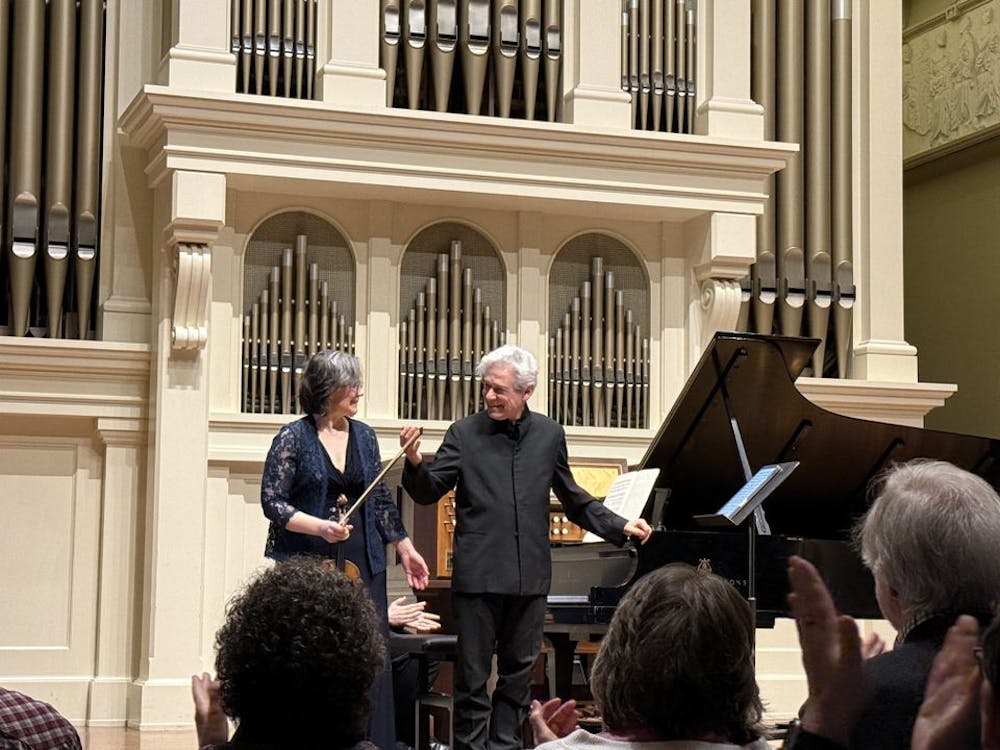The Duo Ingolfsson-Stoupel took on the Leith Symington Griswold Hall at the Peabody Institute on Sunday, Feb. 2. They gave an incredible concert featuring works by Simon Laks, Olivier Messiaen, Ludwig van Beethoven and Maurice Ravel.
Judith Ingolfsson, a violinist and faculty at the Peabody Institute, and her husband Vladimir Stoupel, a pianist, have been playing together for well over 20 years. They initially met through an unexpected encounter in New York City after Stoupel had been stood up by his violinist for a concert at Bargemusic, and Ingolfsson filled in as the substitute. Since then, they have performed in various venues across the world as a renowned duo.
They began the afternoon concert with the Trois Pièces de concert by Laks. Born in 1901, Laks was a Polish-Jewish composer and violinist. During the Holocaust, Laks was deported to Auschwitz, where he became the head of the prisoners’ orchestra. Before his deportation, the piece was composed while he was in Paris, with versions for both the violin and cello, but the violin version was lost. According to Stoupel, this performance was a reconstructed version for the violin by Ingolfsson.
The opening movement, “Prélude varié,” began with simple, open textures. An airy and playful character brought pleasant images to the listener’s mind, reminiscent of blooming meadows, cozy cottages and gentle breezes. Following this was the “Romance,” in which an expressive melody from Ingolfsson’s violin soared above serene, tranquil chords in the piano. And the final movement, “Mouvement perpétuel” (“perpetual movement” in English), — characterized by fast, running notes — depicted never ending activity, like cogs and gears in a machine or the hustle and bustle of a crowded city. The duo seamlessly spun out phrase after phrase, and, even after the piece ended, one could still feel the music resonating, pulsating and propelling perpetually in space.
Next on the program was “Louange à l’Immortalité de Jésus” (“Praise to the immortality of Jesus”) from Quatuor pour la fin du temps (Quartet for the End of Time) by Messiaen. Messiaen (1908–1992) composed this piece whilst prisoner in Stalag VIII-Aa World War II prisoner camp in Germany. In the preface to the score, he wrote that this movement is “aimed towards the second aspect of Jesus, Jesus the Man, the Word made flesh, immortally risen for our communication of his life. It is all love.”
The Messiaen was followed by Ravel’s Sonata for Violin and Piano. The music, though written by a French composer, had clear influence from American music forms like jazz. In the first movement, titled “Allegretto,” open, smooth melodies flowed like water through the hall. The second movement was called “Blues. Moderato,” and had the clearest inspiration from American music as Stoupel played crisp, staccato chords underneath Ingolfsson’s jazzy melody, denoted by the title. And finally there was another “perpetual movement” (“Perpetuum mobile. Allegro”). Similar to the third movement of the Laks, the violin was frenetic and buzzing, like a swarm of bees. The duo’s performance delivered an electrifying end to the first half of the concert.
The duo choose their music program by considering various perspectives of the impact the concert has to make each performance special, such as the event date, venue and significance towards their particular audience. In an interview with The News-Letter, Ingolfsson described the duo’s thinking process behind the repertoire for this performance.
“Well, you may have noticed that Ravel [recently] had his 150th birthday celebration,” Ingolfsson said. “That’s where we kind of started; our programs generally tend to make connections between composers and historical connections... even if we are discovering newer repertoire or finding and researching repertoire that has been neglected or hasn’t been printed, we still bring out favorite pieces that we have discovered back [into our programs]. Our programs often go through cycles of three to four years, and then we will bring them back.”
In addition, Stoupel also mentioned the importance of French music for the duo, and how they would like to represent this music more in their performances.
“It’s not only that the work is our passion, but French music is our passion,” Stoupel stated. “If you look at the average programming of French music, it is represented only in a small percentage. And we would like to bring this great music to the border.”
After intermission, the couple performed Beethoven’s Sonata for Violin and Piano No. 10, Op. 96. The opening gesture, beginning with a trill, set the mood with a calm and ethereal aura. The duo performed with immaculate control of sound and tone, making the notoriously difficult piece look and sound effortless. The 27-minute work seemed to pass in one — each movement highlighting the different characters intended by the composer.
Not only are these concerts memorable for the duo, it also includes their son, Alan Stoupel, who is a violinist in the Peabody Preparatory. In the interview, the couple mentioned how performance venues during COVID-19 only allowed for family members to be on the stage, and, therefore, the only person who could page flip for the piano was the young Stoupel. Since then, their son has been more involved in their musical journey, and has turned performances into an entire family experience.
“We were lucky today, because [Alan] charges five more dollars per repeat,” Stoupel said, implying that the pieces within this program had fewer repeats than normal. “He started pretty early with $5 per repeat... he was perfect.”
The finale for the night was Ravel’s Tzigane for Violin and Piano. The piece explored all kinds of techniques on the violin in a rhapsodic style, bolstered with atmospheric colors from the piano.
“I’ve been playing it [The Tzigane] since I was maybe 14 or 15,” Ingolfsson said. “It’s kind of like an oldie for me.”
This fact was made apparent through the duo’s performance as they displayed remarkable technical brilliance and emotional nuance, captivating the audience until the final note.





